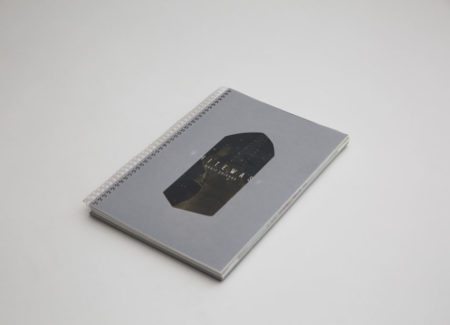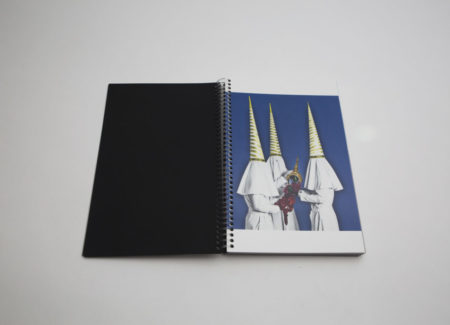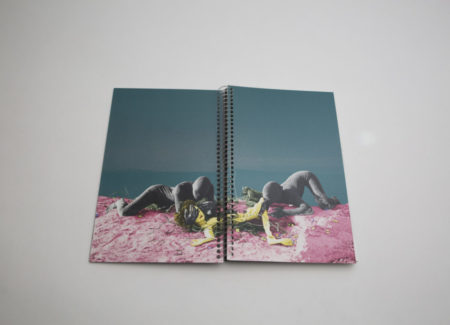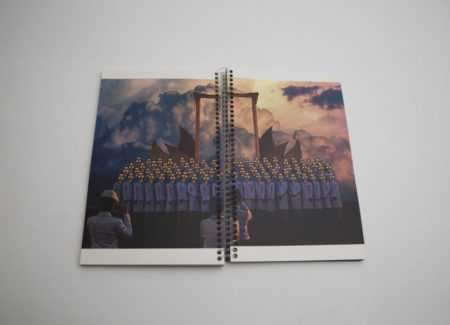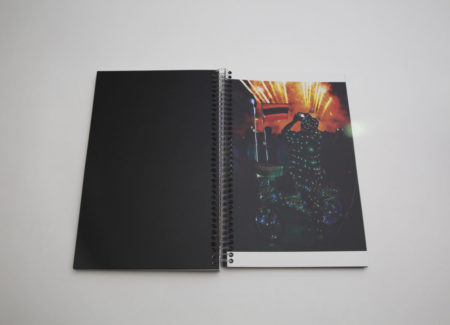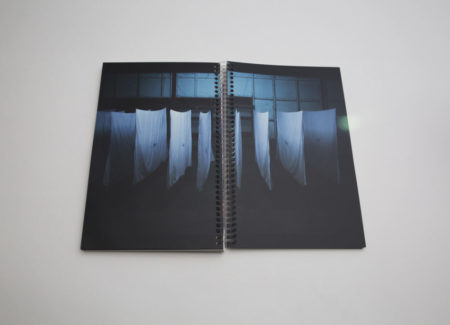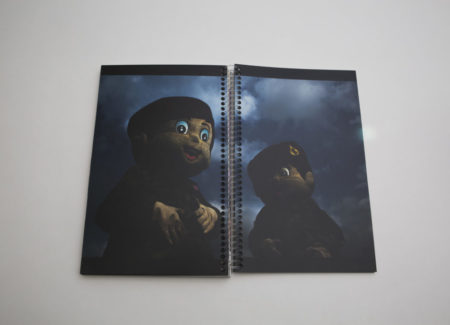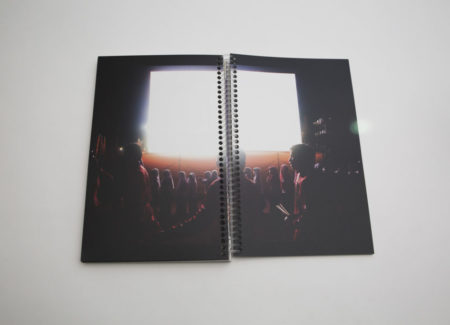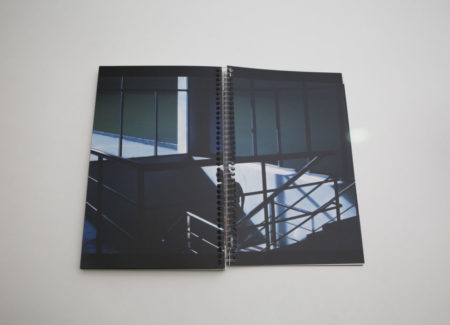JTF (just the facts): Published in 2017 by Akina (here). Spiral-bound with transparent coil, die cut cover, 128 pages, with 45 color collages/photographs and 9 sketches. There are no texts or essays. (Cover and spread shots below.)
Whitewash is also available in a special edition (here). This version includes a signed book in a custom-made slipcase and one of two photorag prints. In an edition of 20 copies.
Comments/Context: In the summer of 2017, Thai soldiers entered a Bangkok gallery that was exhibiting the work of Harit Srikhao, a young Thai photographer who uses his art to reflect on the political landscape of the country. While the details of this particular act remain unclear, several photographs were taken down, along with a sketch and a seven-page note. Of course, no artist wants his or her artwork censored, and yet, given Srikhao’s own journey to understand the culture of propaganda that has grown up inside in his home country, the irony of the event is somehow fitting – after creatively trying to see the world from his own vantage point and get out from underneath the government-controlled mindset, his show was bluntly edited by that very same machine.
Srikhao’s artistic awakening began with his memories of the “Big Cleaning Day”, which took place in May of 2010 and was organized by the Bangkok Metropolitan Administration after a two-month period of ongoing political demonstrations. On that day, Srikhao and his family participated in the clean up along with other families, teenagers, celebrities, elderly people and even foreigners. Fifteen years old at the time, he wasn’t politically involved and didn’t understand much about the ongoing protests.
It took Srikhao years to see the bigger picture of Thai politics. As he became curious about the political situation in Thailand and learned more about the country’s nuanced history, he realized that everything he knew was rather one-sided, a cleaned-up version presented by the government through its extensive propaganda machine. Srikhao’s engaging photobook Whitewash tries to rectify that brainwashing, combining images from his two most recent series. It artfully questions the existing social hierarchy and brings attention to the political situation in his homeland, with the hope that more people will start asking themselves some of the same questions he did.
The title of the book, Srikhao explains, “means to suppress all guilt from the past and from history, it is a rite of exoneration”. Whitewash is a spiral-bound book, which allows it to lay completely flat and also adds a distinct element to its design, as the coil runs through the center of the images. Its unusual visual language makes the the photobook immediately stand out, the pictures filled with grotesque staged compositions, cut outs, collage elements, and chemical manipulations directly on the negatives.
In the first part of the book, drawn from the “Mt. Meru” series, Srikhao uses Hindu mythology to create a mysterious and bizarre fantasy world. In the sequence of forteen images, often staged with models in anonymous colored bodysuits, he plays with the absurdity of hierarchy and upends the sacred status of the monarchy in Thailand, while also commenting on the use of imagery by the government as a tool for propaganda.
The opening image depicts three figures dressed in white robes, wearing full-faced cloth masks with eyeholes and tall pointy white hats decorated with a golden spirals. Placed against a blue background, they stand together holding what looks like a messy bunch of organs, soon to be adorned with a regal Thai crown. The caption in gold reads: “The coronation of Brukhonenko’s Dog”, creating a biting comparison between the monarch and the head-severed-from-body experiments of a 1930s Soviet scientist. The next work (captioned as “The Portrait of An Apsara”) depicts a reclining female figure in a classic odalisque pose, except the woman is outfitted with a head to toe black bodysuit and rubber breasts and surrounded by fawning attendants. Other pictures recreate stylized scenes filled with bowing, kneeling, kissing, and other forms of supplication, the central figure of worship often a withered golden doll empty of life, the peculiar compositions and references undermining the supposed earnestness of the events.
The second chapter of the book offers photographs that Srikhao has turned into a different type of fiction. He started by revisiting the places where he went as a student for moral instruction and indoctrination – the temple, a military camp, the National History Museum, etc. The first photograph shows young boys with guns, probably at school where they were learning to use them. It is followed by an image of a family, where the man holds a little boy dressed in military fatigues. Srikhao has cut out the faces of the adults, leaving only their eyes and mouth, the effect something like the parents are wearing ski masks. A third image depicts a row of women holding their hands in prayer, all wearing similar white dresses, but their faces are cut out, leaving just dark holes decorated by pinpricks of light. Similar manipulations were applied to other images in this chapter, stripping individuals of their personalities and sentience.
The looming presence of authority (religious, political, cultural) manifests itself in other images. One spread shows uniformed cadets probably taking a break during a school day, with a cartoonish golden statue with big eyes and red lips inserted by Srikhao dominating the outdoor space and photobombing a selfie taken by friends. In the following image, another group of cadets is shown marching as a giant figure of a dog appears above, as if they are saluting it. Srikhao describes these manipulations as “mental surgery”, saying “I chose to use a paper cutter instead of using Photoshop as it left scratches and clues that I needed”. This hand-crafted process seems to have helped him to reconsider his own discordant memories and to bring a new awareness of how his own behavior was modified.
Whitewash is an ingeniously multilayered photobook. Taking off from Srikhao’s own uninformed past, the photographs ask citizens to question the dominant structures and norms of Thai society they take for granted. By reconstructing reality with an understated sense of visual satire, his personal reflections become something more symbolically potent, which is probably why they felt threatening to the Thai authorities.
Collector’s POV: Harit Srikhao does not appear to have gallery representation at this time. Collectors interested in following up should likely connect directly with the artist via his website (linked above).
